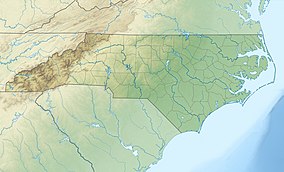Moores Creek National Battlefield
| Moores Creek National Battlefield | |
|---|---|
|
IUCN category V (protected landscape/seascape)
|
|
 |
|
|
Moores Creek Bridge
|
|
| Location | Pender County, North Carolina, United States |
| Nearest city | Wilmington, North Carolina |
| Coordinates | 34°27′29″N 78°06′34″W / 34.45806°N 78.10944°WCoordinates: 34°27′29″N 78°06′34″W / 34.45806°N 78.10944°W |
| Area | 88 acres (36 ha) |
| Established | June 2, 1926 |
| Visitors | 48,406 (in 2005) |
| Governing body | National Park Service |
| Website | |
|
Moore's Creek National Military Park
|
|
| Nearest city | Wilmington, North Carolina |
| Area | 44.3 acres (17.9 ha) |
| Built | 1776 |
| NRHP Reference # |
66000070 (original) 86003649 (increase) |
| Significant dates | |
| Added to NRHP | October 15, 1966 |
| Boundary increase | February 13, 1987 |
Moores Creek National Battlefield
Moores Creek National Battlefield is a United States National Battlefield managed by the National Park Service. The park commemorates the 1776 victory by a thousand Patriots over about eight hundred Loyalists at the Battle of Moore's Creek Bridge. The battle dashed the hopes of Royal Governor Josiah Martin of the Province of North Carolina for regaining control of the colony for the British crown. The Loyalist defeat ended British plans for an invasionary force to land in Brunswick Town, North Carolina. North Carolina voted to declare independence from the British on April 12, 1776, shortly after the victory at Moore's Creek, which is located in the Wilmington area near Currie in Pender County in southeastern North Carolina. The park was established as a National Military Park on June 2, 1926 and was redesignated as a National Battlefield on September 8, 1980.
Loyalists, mostly Scottish Highlanders, many of whom did not have muskets and were wielding broadswords, expected to find only a small Patriot force on February 27, 1776. Before the arrival of the Loyalists, the Patriots removed the planks from the bridge that crossed Moore's Creek. After removing the planks of wood, they smeared the remaining crossing beams with lard. This forced the Loyalists to cross the bridge in single file. As the Loyalists advanced across the bridge, Patriot shots rang out and dozens of Loyalists fell into the creek below, including their commanders. At the time, the creek was an estimated six feet deep. One commander, Lieutenant Colonel Donald McLeod, died in the battle. Another commander was Colonel Allan MacDonald, the husband of Flora MacDonald of Highland lore who aided Bonnie Prince Charlie following the Jacobite defeat at Culloden Moor in 1746.
...
Wikipedia



